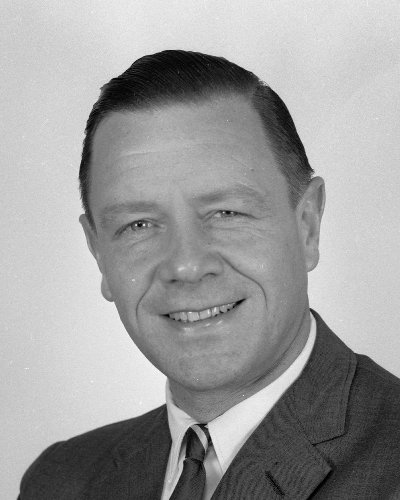 John W. Findlay, 1963 (NRAO/AUI/NSF image)
John W. Findlay, 1963 (NRAO/AUI/NSF image)
John W. Findlay
Contributed by Ellen N. Bouton
John Wilson Findlay, a leader at NRAO for nearly three decades, was born in Kineton, England on 22 October 1915, received his BA from Cambridge University in 1937, and his PhD in physics from Cambridge in 1950. He served in the Royal Air Force between 1939 and 1945, and supervised the installation of radar stations throughout the Middle East and Asia. Following the War he led a radar development group in Britain and did research in ionospheric physics. From 1945 to 1953 Findlay held teaching positions at Cambridge University and was a Fellow of Queen's College. He was a member of the staff of the British Ministry of Supply, 1954-1956. At the invitation of NRAO founder and AUI President Lloyd Berkner, Findlay joined the staff of the National Radio Astronomy Observatory (NRAO) on 27 December 1956 as employee number 5 and the second member of the scientific staff, and, served the NRAO in various capacities until his retirement in 1985. After retirement he continued as a consultant to NRAO until his death on 22 March 1994.
NRAO was founded in November 1956, and Findlay played a major role in NRAO's the planning and development. He started the Electronics Division, and later served as Deputy Director and as Assistant Director for NRAO's Green Bank, WV, facility. He led NRAO's efforts in the design of new antennas. He planned and supervised the design and fabrication of the 300 Foot Telescope in Green Bank and the 36 Foot Millimeter Telescope on Kitt Peak near Tucson, AZ, as well as the upgrading of the 36 foot to a 12 meter configuration. He was the leader of the technical group responsible for the design and construction of the Very Large Array antennas. During the 1960s he led a small team investigating the design of the Largest Feasible Steerable Telescope, and later led the groups designing the proposed 65 meter and 25 meter millimeter-wave telescopes. One of Findlay's best-known contributions to astronomy was his effort over a long period of time to establish an absolute calibration at 21 cm, for which he constructed in Green Bank the Calibration Horn Antenna, known as Little Big Horn, and which he used for observations over a number of years.
During 1965 to 1966, while on leave from NRAO, Findlay served as Director of the new Arecibo Observatory. Throughout his career he was involved in the international effort to protect radio astronomy frequencies from interference. From 1967 through the 1980s he was a member of the U.S. Committee on Radio Frequencies (CORF) and the IAU-URSI-COSPAR Inter-Union Committee on the Allocation of Frequencies, serving as chair of both bodies. He was a member of the National Academy of Sciences Space Science Board, and from 1967-1971 was Chair of the Lunar and Planetary Missions Board which advised NASA on the planning and conduct of all missions to the Moon and planets, including the manned Apollo missions to the Moon. It was John Findlay, who first suggested that the Apollo mission carry live television from the Moon.
Findlay was a Member of the Order of the British Empire, a Fellow of the Institute of Electrical and Electronics Engineers, a Fellow of the British Institute of Physics, and a Fellow of the American Association for the Advancement of Science.
![[IAU logo]](iau_wb_thumb.jpg)
![[URSI logo]](URSI-logo-thumb.jpg)
![[Karl Jansky at his antenna]](jansky_photo_02_thumb.jpg)
![[Reber's Wheaton antenna]](Reber_Telescope_Wheaton_thumb.jpg)
![[Dover Heights]](Dover_Heights_02_thumb.jpg)
![[4C telescope]](GB61-195_4C_telescope_thumb.jpg)
![[Ewen and horn antenna]](ewen_horn1s.jpg)
![[Dwingeloo, 1956]](Dwingeloo-1956-thumb.jpg)
![[Jocelyn Bell Burnell and Cambridge antenna used in pulsar discovery]](burnell2_thumb.jpg)
![[Lovell Telescope at Jodrell Bank]](site_1594_0001-500-334-20180316163019-thumb150.jpg)
![[Wilson, Penzias, and Bell Labs horn antenna]](wilson-penzias-horn_thumb.jpg)
![[6-m Millimeter Radio Telescope in Mitaka, Japan]](6m-thumb.jpg)

